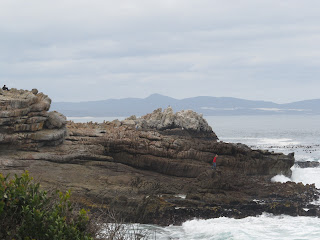Big post today because Tsitsikamma/Storms River Mouth was incredible. I was feeling great after my 24 hours in Jeffrey's Bay and leaving JBay was a bit disppointing. Little did I know though was that Storms River Mouth would be even better!
Tsitsikamma (and Knysna) is essentially all of the natural occurring forests in South Africa. Less than 1% of SA is natural forest so Tsitsikamma is very special. As the tour was showcasing SA's forests, Tsitsikamma was an absolutely necessary stop. Because of the conservation efforts in this area and because we would be examining the conservation, we stayed in the staff accommodation at SANParks Garden Route National Park (Storms River Section).
We arrived late in the evening so it was dark and we were all quite tired. But after a good braai and sleep I was ready for Sunday morning. Sunday was a free day so we were in no rush to get up. But while eating breakfast, I got to see the visitor's to our cabin.
There was a troop of baboons in the forested hillside but this one was the only one who was curious enough to come investigate. He found an orange peel that had been left on the ground the night before and after attempting to distract us from it by throwing rocks, ran and grabbed it. He was very entertaining and I think really wanted the apple I was eating!
Because I joined the tour mid-week, everyone else was pretty much out of clean clothes. We drove down the hill to the main camp and laid on the grass while waiting for laundry. Oh yeah, this was the view. Absolutely gorgeous, the ocean waves and the rocks. Being the southern cape, this is still the Indian ocean.
Not too far away from us, there was a group of rock hydraxes, or Dassies (da-ah-c's) which look like large gophers or prairie dogs. They are really cute and will jump and run around quite happily. Interestingly, their closest relative in the animal kingdom is not the rabbit or gopher or badger but the elephant! Despite their size, they are not actually rodents.
Later in the afternoon we decided to hike to a waterfall we had heard was on the coast and not too far away. It was actually a pretty long hike and difficult because we had to walk on the rocky shoreline for a fair distance. My knee was quite sore but it was well worth it.
This cave was the halfway point along the hike. It was right on the shoreline and went back farther than we could explore without a flashlight or torch. Even that far back though, there was still plenty of head room so I think it would go on for a while.
I walked in a little ways (small spaces are not really my thing so I didn't go too deep) but the view back to the ocean was pretty impressive.
We finally reached the waterfall which was completely worth the distance.
Right on the shoreline, this is the upper pool. The water was freezing cold, but some of the guys decided to swim. There was a fairly cool breeze coming in off the ocean so they were very brave! I think the beer they decided to chill in the pool helped them a bit.
This is the lower pool of the waterfall, and the rocky "wall" of the left has several gaps where the waterfall mixes with the sea. It looks nice and foamy almost like a bubble bath. It was really beautiful. We couldn't stay too long though because the sun was starting to set. It was good we left when we did because the trail was not well marked and we took a few wrong turns on the way back. But next time, I'm definitely planning to spend more time at the waterfall!
The next morning we stopped at the main camp again before we left for the day's activities. The sunrise over the ocean (and river to the left in the photo) was so beautiful and peaceful.
Next post, I'll show the sawmill and some of the natural forests we saw!





















































